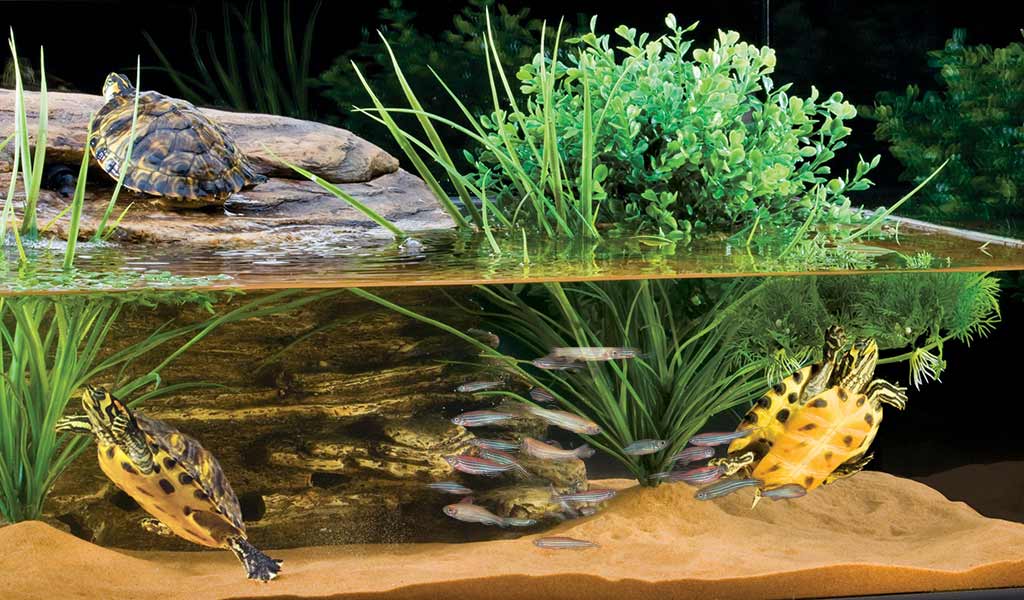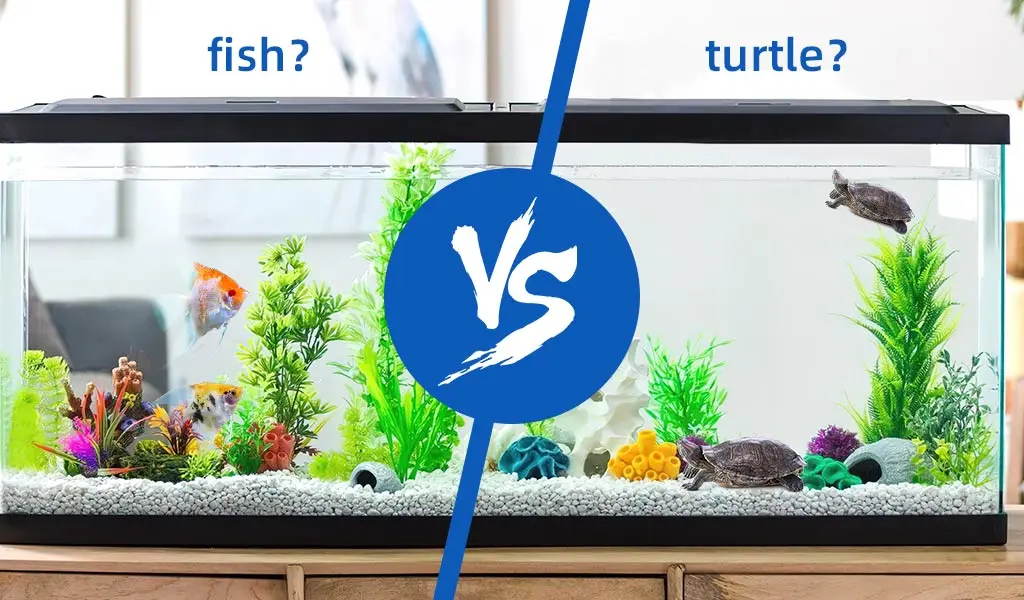Certain fish like guppies, tetras, and zebra danios can coexist with turtles. They are fast and small, avoiding turtle aggression.
Turtles are fascinating pets, but they can be challenging to house with other creatures. Choosing the right fish to live with turtles is crucial for maintaining a harmonious aquarium. Fish like guppies, tetras, and zebra danios are ideal because of their speed and small size, which help them evade turtle aggression.
Keeping an eye on the compatibility of species ensures the well-being of all aquarium inhabitants. A balanced ecosystem not only enhances the visual appeal but also contributes to the health and longevity of both turtles and fish. Always monitor interactions to prevent stress or injury among tank mates.
Factors To Consider
Choosing tank mates for turtles can be tricky. Turtles have specific needs and behaviors. Not all fish will be a good fit. Consider these factors before adding fish to a turtle tank.
Tank Size
Tank size is crucial. Turtles need space to swim and explore. Fish need space too. A small tank can cause stress and aggression. A larger tank reduces these risks. It also provides more hiding spots for fish. Minimum tank size should be 75 gallons for turtles and fish.
Water Conditions
Water conditions must suit both turtles and fish. Turtles need clean water, so do fish. Use a strong filter to keep water clean. Water temperature is important too. Turtles prefer warm water, around 75-80°F (24-27°C). Choose fish that thrive in similar temperatures. pH levels should be neutral, around 6.5-7.5.
Diet Compatibility
Diet compatibility is key. Turtles are omnivores. They eat plants and animals. Fish have varied diets. Ensure the fish diet matches the turtle’s diet. This prevents food fights and ensures all pets are healthy. Avoid feeder fish. Turtles may see them as food, not friends. Opt for fish that turtles do not eat easily. This keeps the tank peaceful.
Best Fish For Turtle Tanks
Choosing the best fish for turtle tanks can be tricky. The right companions can create a balanced aquarium. Below are some great options for your turtle tank.
Guppies
Guppies are small and colorful. They adapt well to turtle tanks. They are fast swimmers, which helps them avoid turtles. They eat algae and leftover food, keeping the tank clean.
- Bright colors
- Fast swimmers
- Easy to care for
Platies
Platies are another good choice. They are peaceful and can live with turtles. Platies come in many colors and patterns. They thrive in similar water conditions as turtles.
- Peaceful nature
- Variety of colors
- Compatible water conditions
Mollies
Mollies are hardy fish. They get along well with turtles. Mollies help control algae in the tank. They are also easy to breed. This makes them a sustainable choice for turtle tanks.
- Hardy and robust
- Control algae
- Easy to breed
Cichlids And Turtles
Keeping cichlids with turtles can be a rewarding experience. These fish are known for their vibrant colors and active behavior. They can coexist with turtles under the right conditions. Let’s explore the pros and cons and popular cichlid choices.
Pros And Cons
Understanding the pros and cons helps ensure a harmonious tank environment. Here’s a quick comparison:
| Pros | Cons |
|---|---|
|
|
Popular Cichlid Choices
Choosing the right cichlids is crucial for a peaceful tank. Here are some popular choices:
- Convict Cichlids: Hardy and adaptable.
- Oscar Cichlids: Large and colorful.
- Angelfish: Graceful and elegant.
Bottom-dwellers
Turtles are fascinating pets, but they need compatible tank mates. Bottom-dwellers are perfect companions. They live at the bottom of the tank. This keeps them out of the turtle’s way. They are also hardy and can handle different water conditions. Here are some great bottom-dwelling fish to consider.
Corydoras Catfish
Corydoras Catfish are small, peaceful fish. They clean up leftover food, keeping your tank clean. Corydoras are social and like to be in groups. Here are some of their key features:
- Size: 2-3 inches
- Diet: Omnivorous, eat sinking pellets and flakes
- Temperament: Peaceful and social
| Characteristic | Details |
|---|---|
| Size | 2-3 inches |
| Diet | Omnivorous |
| Temperament | Peaceful and social |
Corydoras also help with tank maintenance. They eat algae and detritus. This keeps the water clean and healthy for your turtle.
Plecos
Plecos are another great choice. They are hardy and can grow quite large. Plecos are known for their algae-eating abilities. Here are some important points about Plecos:
- Size: Varies, can reach up to 24 inches
- Diet: Herbivorous, mainly algae and vegetables
- Temperament: Generally peaceful
| Characteristic | Details |
|---|---|
| Size | Up to 24 inches |
| Diet | Herbivorous |
| Temperament | Generally peaceful |
Plecos also help keep the tank clean. They eat algae off the tank walls and decorations. This reduces maintenance and keeps the environment healthy for your turtle.
Fish To Avoid
When housing fish with turtles, some species can cause problems. It’s important to avoid these fish to keep a peaceful tank environment. Here are the types of fish you should steer clear of:
Aggressive Species
Aggressive fish can harm turtles. They may bite or chase them. Here are some examples:
- Cichlids: Known for their territorial behavior.
- Betta Fish: They can be very aggressive.
- Oscars: These fish often fight with others.
Fin Nippers
Fin nippers can cause stress for turtles. They often bite at the fins of other fish and sometimes turtles. Here are some common fin nippers:
- Tiger Barbs: Notorious for nipping fins.
- Serpae Tetras: Known for their fin-nipping habits.
- Guppies: Can sometimes nip at fins.
Ensuring the right mix of fish and turtles can create a harmonious tank. Avoid these problematic species to keep your aquatic pets happy.

Credit: bandhturtlesite.weebly.com
Setting Up The Tank
Creating a balanced tank for turtles and fish can be challenging. Both need specific conditions to thrive. Here are the steps to set up the perfect tank.
Creating Hiding Spots
Fish need places to hide from turtles. Use rocks, caves, and plants. Live plants like Java Fern and Anubias work well. They provide cover and help clean the water.
Artificial plants are also a good option. They require less upkeep. Make sure to place them in corners and along the back of the tank.
Rocks and caves give fish a safe place to retreat. Arrange them to create small nooks and crannies.
Balancing The Ecosystem
Maintaining a balanced tank is crucial. Turtles produce a lot of waste. This can affect water quality and harm fish.
A strong filtration system is necessary. It helps keep the water clean. Look for filters designed for turtle tanks. These filters handle more waste than regular ones.
Check the water parameters often. Use a test kit to monitor pH, ammonia, and nitrate levels. Make sure the tank stays within safe ranges.
Feed both turtles and fish a balanced diet. Turtles eat both plants and protein. Fish may need specific food depending on the species.
| Item | Purpose |
|---|---|
| Live Plants | Provide cover and clean water |
| Artificial Plants | Low maintenance hiding spots |
| Rocks and Caves | Safe retreats for fish |
| Filtration System | Keep water clean |
| Test Kit | Monitor water parameters |
Maintaining Harmony
Ensuring harmony in a tank with both fish and turtles is vital. Turtles can be aggressive, so careful selection of tank mates is essential. This section will guide you on maintaining a peaceful environment.
Monitoring Behavior
Regularly observe your tank to see how the fish and turtles interact. Watch for any signs of aggression from the turtles. Turtles might chase fish, which can cause stress.
Use a table to track behavior patterns. This helps you notice any changes quickly.
| Day | Behavior Observed |
|---|---|
| Monday | No aggression, fish active |
| Tuesday | Turtle chased fish once |
| Wednesday | No issues observed |
Signs Of Stress
Stress in fish can lead to serious health issues. Look for these signs to ensure your fish are happy:
- Hiding more than usual
- Loss of color
- Erratic swimming
- Loss of appetite
If you see these signs, consider separating the fish and turtles.
Provide plenty of hiding spaces for fish. This can reduce their stress levels.
Choose fish that are fast swimmers and can avoid turtles. Some good options include:
- Zebra Danios
- Guppies
- Platies
These fish are known for their speed and agility, making them good tank mates.

Credit: www.hygger-online.com

Credit: www.hygger-online.com
Conclusion
Choosing the right fish to live with turtles can create a harmonious tank environment. Ensure compatibility to avoid stress and aggression. Stick to hardy species like guppies, minnows, and tetras. Proper care and monitoring will keep both fish and turtles healthy.
Happy tank mates lead to a thriving aquatic habitat.
